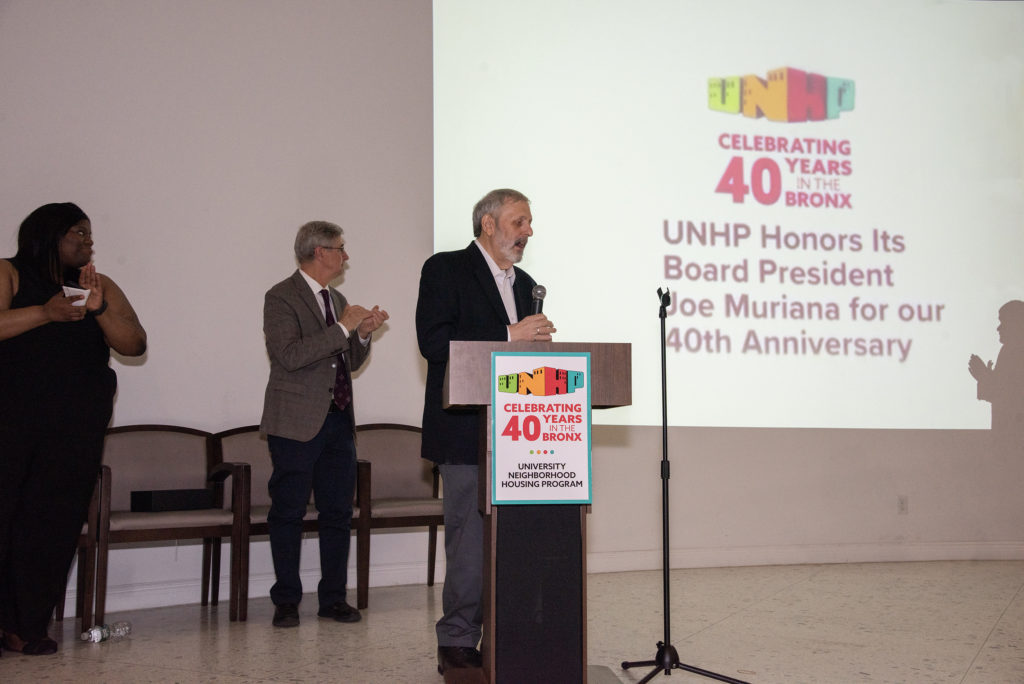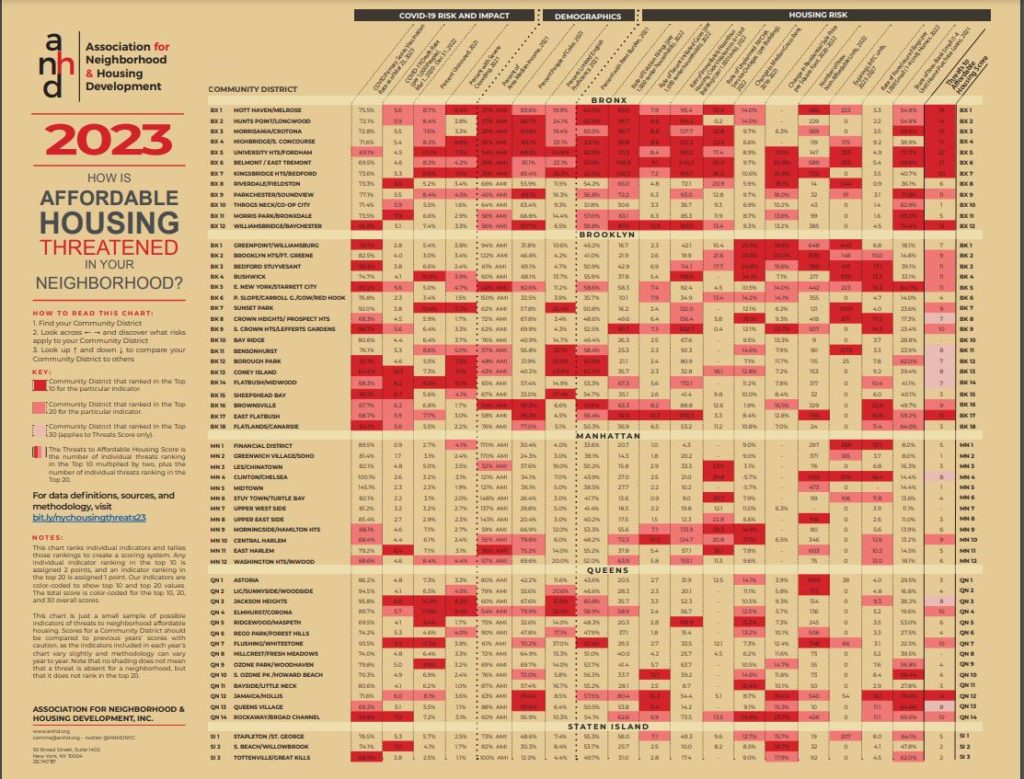
Photo by José A. Giralt
The University Neighborhood Housing Program (UNHP) was created in 1983 by Fordham University to help Bronxites take ownership of community-based redevelopment efforts. On Thursday, April 27, the organization celebrated 40 years with an event entitled “40 & Still Fighting Fiesta” held at Serviam Hall in Bedford Park.
The organizers also used the occasion to honor UNHP board president, Joe Muriana. It was as a member of Fordham University’s Office of Government & Urban Affairs that Muriana began his relationship with UNHP. “I was the assistant director for urban affairs,” he told Norwood News. “[UNHP] was in part a creation of Fordham University. Its board of trustees created it to be a mechanism for the University to become more actively engaged in the neighborhoods on an institutional level in terms of [investment] deals.”
Prior to working at UNHP, Muriana worked as a community organizer with the Northwest Bronx Community and Clergy Coalition (NWBCCC) in the mid-70s, initially while still a student at Fordham University. He was later hired as a staff member after graduation. He considers his time at NWBCCC as invaluable in terms of learning the needs of the local community and how best to provide needed services, especially financial strategies to fund home ownership.
As board member of a nonprofit organization, Muriana does not draw a salary. During his time as board president, he said he has seen how the quest for profits has transformed the real estate environment in The Bronx. “When we started out, people were walking away from buildings,” he said. “You could buy a deed, literally, for a few hundred dollars, if not less. What we were able to do was to get some people to agree to put money and park it with University Neighborhood… and we would use that money to begin to renovate buildings. But, all the pricing was reasonable then.”
Muriana said the concept of collecting money from residents to buy inexpensive properties has long disappeared, however. “We couldn’t do it at a collection taken up at church,” he said. “We have to have a different approach.” Now, Muriana and UNHP look toward much bigger entities to secure financing options with more complex financial arrangements. “We can get money to do renovation work through a combination of New York City programs, some federal programs, and some private banks,” he said.
Indeed, UNHP lends money towards renovations through its Green Loan Fund. UNHP has used Green Loans to fund roof replacements, boiler repair and other work that reduces operating costs and saves energy.
The need to maintain a multitude of partnerships to keep UNHP on track with its mission to ensure affordable housing was reiterated during the celebration by Jim Buckley, executive director. Buckley acknowledged the sponsorship of financial institutions like Apple Bank, M&T Bank, Amalgamated Bank, Webster Bank, and JP Morgan Chase, among others. “The ability to have partnerships with such a wide variety of people and organizations is one of the things that sets UNHP apart,” he said.
The 40th anniversary event took place before the publication of a report by the Association for Neighborhood & Housing Development (ANHD) on May 15, which ranked 18 indicators of risk to affordable housing in each of the City’s 59 community districts (CDs). “This year’s risk chart highlights that in low-income communities of color, new units are priced well out of reach for the vast majority of residents,” an extract read in part.
The report found that Bronx CDs ranked highest for threats to affordable housing citywide. Compounding risk factors pointed to long-standing disinvestment from Bronx communities, particularly those with the highest shares of people of color. Bronx CD 1 through 7, spanning west of the Bronx River up to Woodlawn Cemetery, all ranked in the top ten overall threats to affordable housing.
Meanwhile, Bronx CDs 1 to 7 and Bronx CD 12, generally covering Wakefield, Williamsbridge and Baychester, ranked particularly high for eviction filings (between 83 and 121.3 per 1,000 renter households), rent burden (between 59.8% and 64.3%), tenant-initiated housing court cases (between 7.2 and 10 cases per 1,000 renter households), immediately hazardous housing violations (between 95.4 and 244.3 per 1,000 units in 6-unit or more buildings), and unplanned NYCHA service outages (between 13.4 and 56 per building).

Source: Association for Neighborhood & Housing Development (ANHD)
These same districts are among those with the lowest income (between 27% of the Average Median Income (AMI) and 56% of the AMI). They have the highest shares of people of color (between 81.1% and 90.6%), have the highest shares of limited English proficiency (between 19.4% and 26.3%), have high shares of uninsured residents (between 7.6% and 10.1%), and have comparatively low recorded COVID vaccination rates (between 70.4% and 73.2%).
The work of UNHP is felt by Bronxites across the borough. Bedford Park resident, Nelson Guzman, has lived in a building on East 198th Street for a little more than a year. He found his apartment with the help of UNHP. “I’m grateful to the organization, the institution, with their programs,” he said in his native Spanish. “I live alone so I’m appreciative of all the help they offered me.”
Meanwhile, in Co-op City, Esbelin Guzman (no relation to Nelson) and her husband, Julio Almonte, were also helped by UNHP with a myriad of paperwork necessary to become homeowners. Speaking to Norwood News in Spanish, Guzman, 65, described the 6-year journey to securing their permanent Co-op City apartment as one filled with financial education training, tax preparation, and a wait-and-see approach.
The couple began working with UNHP in 2016, and when they found a place they liked, they moved in in February 2022. “From the beginning, they helped me with a [training] course on finances, and then they helped us with our taxes,” Guzman said. She credits that training with helping them to be better prepared when shopping around for financial services from different banks. “Today, we own our apartment thanks to this organization and its personnel.” She added, “They were super, super excellent. I feel like we were treated like family. Both my husband and I are very grateful and blessed.”
For details of recently announced affordable housing lotteries, click here, here, here and here. Some deadlines are fast-approaching.
*Síle Moloney contributed to this story.




